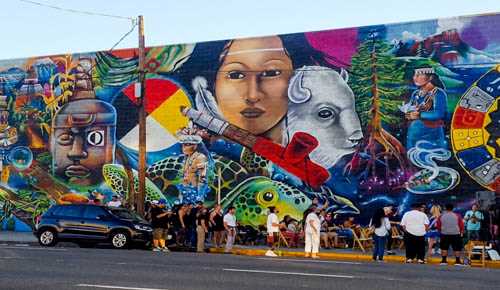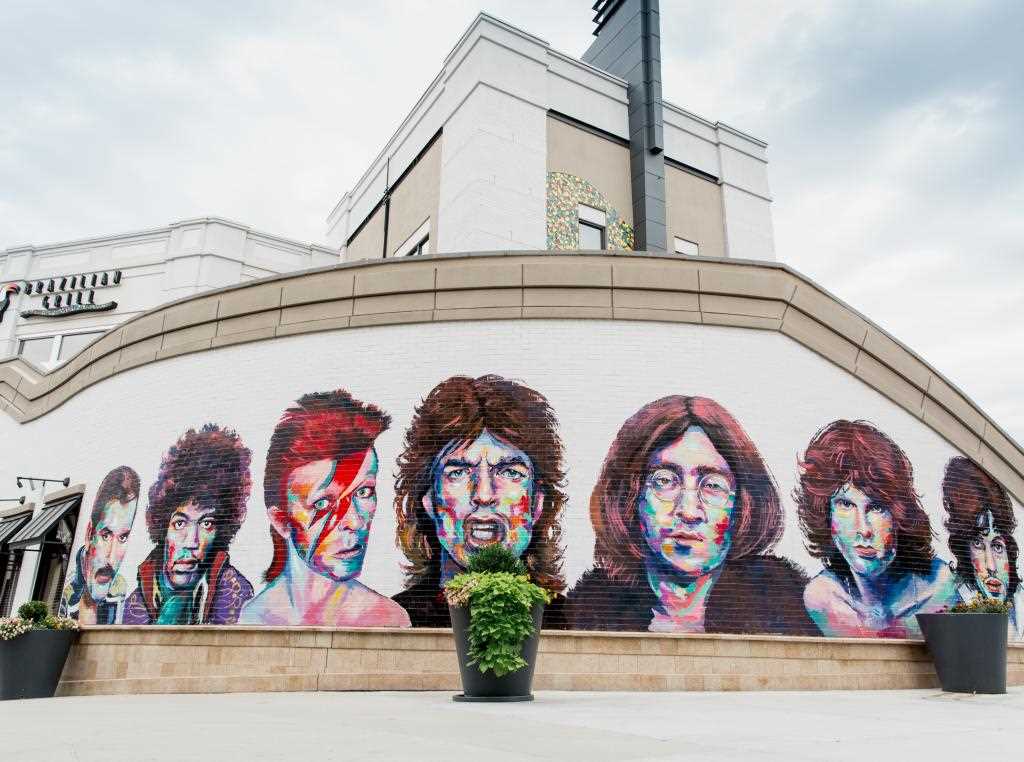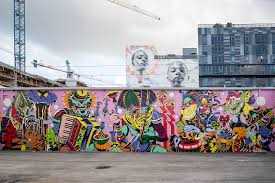The urban environment has long been a canvas for artistic expression, and nowhere is this more evident than in the vibrant world of street art. From sprawling murals to intricate stencils, street art has transformed city streets into open-air galleries, captivating both locals and visitors alike.
What sets street art apart is its ability to harness the power of creativity to make a statement. It is a form of art that transcends traditional boundaries, challenging social norms and sparking conversations about important issues. Street artists are often anonymous, using pseudonyms or symbols to maintain their anonymity, allowing their work to speak for itself.
Street art is not confined to established art institutions, making it accessible to people from all walks of life. It often emerges from marginalized communities, giving a voice to those who are often unheard. Through their work, street artists bring attention to social, political, and environmental issues, using their art as a tool for activism.
The ephemeral nature of street art adds to its allure and mystique. With the constant threat of removal or defacement, the art becomes a temporary display of creativity in the urban landscape. This impermanence only serves to enhance its impact, urging viewers to fully immerse themselves in the present moment and appreciate the fleeting beauty that street art offers.
Street art has a rich history that dates back several decades, with its roots embedded in various cities around the world. Many artists have contributed to the evolution of this vibrant art form, but there are a few notable pioneers who played a significant role in shaping its trajectory.
Banksy

Banksy, an anonymous British street artist, is one of the most renowned figures in the street art movement. With his thought-provoking stencils and satirical pieces, Banksy has managed to capture the attention of audiences globally. His politically charged artwork often tackles social issues, making profound statements about capitalism, war, and the environment.
Banksy’s unique style and elusive identity have made him a symbol of rebellion and cultural activism. His works can be found in various cities worldwide, and the art community eagerly awaits his next thought-provoking masterpiece.
Jean-Michel Basquiat
Another influential figure in the world of street art is Jean-Michel Basquiat. Hailing from New York City, Basquiat started his career as a graffiti artist in the late 1970s. His bold, expressive style and powerful symbolism set him apart from his contemporaries.
Basquiat’s works often incorporated a mix of text, symbols, and figures that reflected his experiences as an African American in a racially divided society. His art explored themes of identity, racism, and social inequality, challenging societal norms and expectations.
Conclusion
The pioneers of street art, such as Banksy and Jean-Michel Basquiat, have left an indelible mark on the world of art. Through their groundbreaking works, they have not only transformed the urban landscape but also ignited important conversations about social, political, and cultural issues. These artists continue to inspire new generations of street artists, pushing the boundaries of creativity and challenging traditional notions of what art can be.
Sources:
- https://www.tate.org.uk/art/art-terms/s/street-art
- https://www.britannica.com/topic/street-art
Expressing Creativity through Spray Paint

Spray paint has become an essential tool for street artists around the world to express their creativity and push the boundaries of traditional art. With its vibrant colors and versatility, spray paint allows artists to create bold and eye-catching pieces of art on various surfaces, from walls and buildings to sidewalks and train cars.
One of the key advantages of spray paint is its ability to cover large areas quickly, making it the perfect choice for creating large-scale murals and graffiti. Artists can use different nozzle sizes and techniques to create different effects and textures, adding depth and dimension to their artwork. Whether it’s creating intricate stencils or freehand designs, spray paint offers endless possibilities for artists to express their unique style and vision.
Furthermore, spray paint offers a sense of spontaneity and freedom that other art forms may lack. Artists can explore their creativity in real-time, responding to the environment and their surroundings as they work. The fast-drying nature of spray paint allows for immediate feedback and adjustments, giving artists the opportunity to experiment and take risks.
Street artists often use spray paint to address social and political issues, turning public spaces into a canvas for activism and self-expression. Through their art, they can shine a light on important topics and provoke conversations within the community. Spray paint becomes a powerful tool for communication and engagement, allowing artists to connect with people from all walks of life.
Unveiling the World of Murals
Murals have become an integral part of the urban landscape, transforming blank walls into vibrant works of art that captivate the imagination of passersby. These large-scale paintings are a visual representation of creativity and expression, adding color and character to the streets and neighborhoods they adorn.
With roots in ancient civilizations, murals have evolved into a contemporary form of artistic expression. From the caves of Lascaux to the walls of Pompeii, murals have been used throughout history to tell stories, convey messages, and evoke emotions. In the modern urban context, murals have gained a new purpose – they have become a form of public art that engages with the community and promotes social dialogue.
Street artists and muralists from around the world have embraced this medium as a way to connect with people on a deeper level. Their works often reflect the diverse cultures, histories, and identities of the communities they inhabit. Through their art, they challenge societal norms, address social issues, and spark conversations.
Murals have the power to transform neglected and overlooked areas into vibrant and inviting spaces. By revitalizing abandoned buildings, underpasses, and alleyways, murals contribute to the revitalization of neighborhoods and foster a sense of pride and ownership among residents. They create a positive and inclusive environment that encourages people to explore and engage with their surroundings.
The world of murals is vast and ever-evolving. From abstract pieces to photorealistic portraits, from political statements to whimsical creations, there is no limit to the creativity and ingenuity of mural artists. Their works provoke thought, inspire creativity, and challenge us to see the world in a different light.
As the popularity of murals continues to rise, cities and organizations around the world are embracing street art as a means of cultural expression and community engagement. Festivals and events dedicated to murals are held annually, attracting artists and art enthusiasts from all walks of life. Through these initiatives, murals have become a driving force in shaping the urban landscape and promoting a sense of identity and place.
Unveiling the world of murals is an invitation to explore the transformative power of public art and to appreciate the creativity and talent of muralists who bring color, inspiration, and a sense of wonder to our urban environment.
Exploring the Evolution of Graffiti
Graffiti, once seen as an act of vandalism, has evolved into a recognized art form that has contributed to the urban landscape in significant ways. From its early beginnings as a form of personal expression to its current status as a medium for social, political, and cultural commentary, graffiti has undergone a remarkable transformation.
The Origins of Graffiti
The roots of graffiti can be traced back to ancient times, with evidence found in ancient Egypt, Greece, and Rome. These early forms of graffiti served various purposes, such as marking territory, political protest, and personal messages. It wasn’t until the 1960s, however, that graffiti began to emerge as a distinct art form.
The Rise of Graffiti as an Art Form
As more artists began to embrace graffiti as a form of artistic expression, it started to spread beyond New York City, reaching other urban centers around the world. This global proliferation led to the formation of graffiti crews and the development of distinct styles influenced by local cultures and contexts.
The Evolution of Styles
Over time, graffiti styles have evolved and diversified. One of the most prominent styles is wildstyle, characterized by complex, interlocking letters that are often difficult to read. Another style is stencil graffiti, which involves using stencils to create precise images. Other styles include bubble letters, calligraffiti, and muralism.
In recent years, graffiti has also embraced technology, with artists using digital tools and projection mapping to create interactive and dynamic artworks. This blending of traditional graffiti techniques and new technologies has pushed the boundaries of what is possible in this art form.
Graffiti Today
Graffiti has come a long way from its humble origins as a form of rebellion and self-expression. It has become a powerful medium for artists to comment on social, political, and cultural issues, challenging the status quo and sparking conversations. While graffiti still faces criticism and legal challenges, it continues to thrive as an integral part of the urban environment, adding vibrancy and creativity to our cities.
The Impact of Street Art on Society
One of the main impacts of street art is its ability to democratize art and make it accessible to everyone. Unlike traditional gallery art, street art is free and open to the public. It transforms the urban landscape into a vibrant gallery that anyone can visit and appreciate. This accessibility has the power to inspire and engage individuals who may not have had access to or interest in traditional art forms.
Street art also has the ability to create a sense of pride and ownership within communities. When local artists create murals and other street art pieces in their neighborhoods, it can foster a sense of identity and belonging. It allows people to see their own experiences and values reflected in their surroundings, which can instill a sense of pride and attachment to their community.
Furthermore, street art has the power to challenge authority and spark conversations about social and political issues. Many street artists use their work as a form of protest or to bring attention to social injustices. By placing their art in public spaces, they are able to reach a wider audience and initiate discussions that may not have happened otherwise.
The impact of street art on society is not without controversy. Some argue that it is vandalism and a form of illegal activity. However, many cities and communities are embracing street art as a way to beautify their neighborhoods, attract tourists, and stimulate economic growth. The acceptance and appreciation of street art in various communities highlight its positive impact on society.
Embracing Street Art as a Form of Self-Expression
In today’s urban environment, street art has emerged as a powerful tool for self-expression. Unlike traditional forms of art, street art breaks free from the confines of galleries and museums, allowing artists to communicate their messages directly to the public.
Street art provides a platform for individuals to express their thoughts, emotions, and opinions on a wide range of social, political, and environmental issues. Through murals, graffiti, and other forms of street art, artists are able to provoke discussion, challenge societal norms, and inspire change.
The Power of Visual Storytelling
One of the main reasons why street art has gained popularity is its ability to tell stories in a visually compelling way. By using vibrant colors, intricate designs, and thought-provoking imagery, street artists are able to convey complex narratives that resonate with viewers on an emotional level.
Whether it’s a mural depicting the struggles of marginalized communities or a stencil art piece highlighting the dangers of consumerism, street art has the power to engage people and spark important conversations. It provides a voice for those who may not have a platform to express their opinions and brings attention to issues that are often overlooked.
Breaking Down Barriers
Street art has the unique ability to break down barriers between artists and the public. Unlike traditional art forms that can be seen as exclusive or elitist, street art is accessible to everyone. It doesn’t require a ticket or an invitation to appreciate and engage with it.
Street art invites individuals to explore their surroundings, discover hidden gems, and experience art in unexpected places. It adds vibrancy and character to urban landscapes, transforming mundane streets and buildings into open-air galleries.
Moreover, street art blurs the line between the artist and the viewer. It encourages interaction and dialogue, allowing individuals to become active participants in the art. Whether it’s taking photos, sharing their thoughts on social media, or simply admiring the artwork, people become part of the street art experience.
A Catalyst for Change
Street art has the power to inspire change and shape communities. By addressing social and political issues through their art, street artists create a visual record of the challenges and aspirations of their surroundings.
In many cities, street art has become a catalyst for urban revitalization and community empowerment. It has the ability to transform neglected neighborhoods into vibrant cultural hubs, attracting tourists, fostering local pride, and even spurring economic growth.
By embracing street art as a form of self-expression, communities can harness its power to highlight their unique identity and create a sense of belonging. It allows individuals to take ownership of their surroundings and actively contribute to the shared narrative of their community.
Street Art as a Catalyst for Urban Renewal
One of the key benefits of street art as a catalyst for urban renewal is its ability to inspire creativity and imagination. By turning drab and uninspiring walls into stunning works of art, street artists can inspire individuals to look at their surroundings in a new and exciting way. This can lead to a sense of community pride and a desire to improve the overall aesthetic of the neighborhood.
Moreover, street art can also act as a platform for social and political commentary. Many artists use their murals to address important issues such as inequality, discrimination, and environmental degradation. By highlighting these issues, street art can spark conversations and raise awareness among residents and visitors alike.
| Benefits of Street Art as a Catalyst for Urban Renewal |
|---|
| Inspires creativity and imagination |
| Creates a sense of community pride and ownership |
| Acts as a platform for social and political commentary |
| Transforms neglected spaces into vibrant environments |
Additionally, street art has the potential to attract tourists and boost local economies. Many cities around the world have witnessed an influx of visitors eager to explore and photograph the vibrant street art scenes. This increase in tourism can lead to the growth of local businesses, such as cafes, galleries, and shops, and create new employment opportunities for residents.
Appreciating Street Art’s Impact on the Art World
Street art has come a long way from being seen as mere graffiti or vandalism. In recent years, it has gained recognition as a legitimate form of art, with its impact on the art world becoming increasingly evident.
One of the reasons why street art is appreciated is its ability to bring art directly into public spaces. Traditional art forms, such as painting or sculpture, are often confined to museums or galleries, limiting their accessibility. Street art, on the other hand, transforms urban environments into open-air galleries, allowing anyone and everyone to appreciate the art without having to pay an entrance fee or adhere to strict visiting hours.
Moreover, street art has the power to provoke thought and spark conversations. Many street artists use their works to express political or social messages, shedding light on important issues that are often ignored or overlooked. By taking art out of traditional settings and placing it in the public eye, street artists ensure that their message reaches a wider audience. This ability to engage with people on a deeper level sets street art apart from other art forms.
Furthermore, the underground nature of street art adds an element of excitement and intrigue. Unlike mainstream art, which is often predictable and highly curated, street art embraces spontaneity and risk-taking. The artists often create their works illegally, facing the constant threat of prosecution. This element of rebellion and defiance resonates with many people, attracting attention and creating a sense of counterculture.
Street art’s impact on the art world is not limited to its aesthetic value or ability to engage with the public. It has also influenced contemporary art practices and sparked a new wave of creativity. Many traditional artists have been inspired by street art’s use of bold colors, stencils, and typography, incorporating these elements into their own works. This cross-pollination of styles and techniques has led to the emergence of new artistic movements and trends.
Conclusion:


I am a mural enthusiast and a fervent admirer of street art. Rather than creating murals myself, I am passionate about collecting them. My love for street art knows no bounds. I am dedicated to curating and cherishing these artworks that grace the streets. My collection stands as a testament to my profound appreciation for this form of artistic expression.
read about me




